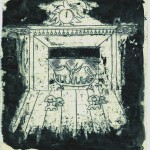Biography
André Breton (1896-1966)
Born on February 18, 1896 in Tinchebray (Orne), Breton’s ancestors were from Brittany and Lorraine. His first years were spent in the care of his maternal grandfather in Saint-Brieuc. When he was four years old, his family went to live in Pantin. In 1906, he was admitted to secondary school at the Collège Chaptal. In 1913, at the age of seventeen, he began studying medicine. The following year, three of his poems, including a sonnet dedicated to Paul Valéry, were published in Jean Royère’s La Phalange. In 1915, Breton was drafted into an artillery unit. After a stint in Pontivy, he was sent to Nantes where he worked in the neurological ward. He began a correspondence with Guillaume Apollinaire and met a young man who would have a determining effect on the rest of his career: Jacques Vaché. Posted in 1917 to the psychiatric ward at Saint-Dizier, Breton was introduced to psychoanalysis. Back in Paris, he went with Apollinaire to Adrienne Monnier’s bookstore where he met Philippe Soupault and Louis Aragon. All three poets began contributing to Nord-Sud, a literary journal edited by Pierre Reverdy.
In 1919, Breton published Mont de piété, which heralded his break with the poetics of Mallarmée. The following year, after stumbling upon automatic writing, he co-authored Les champs magnétiques with Philippe Soupault. In 1919, Breton, Aragon and Soupault founded Littérature. Within one year, the journal had abandoned its rather eclectic modernistic stance in favor of Dada. By September, 1921, when Breton married Simone Kahn, he had already begun to distance himself from Tzara; the two men parted ways definitively in early 1922. By that time, Littérature, Nouvelle Série saw the birth of a group whose Surrealist Manifesto (1924) clarified its positions and questionings. From that point on, Breton’s fate became inextricably linked to surrealism. Around the same time, he published Lost Steps.
In October, 1926, Breton met Nadja, on rue Lafayette. Their relationship spawned a book which spells out surrealism’s main preoccupations: the connections between poetry and life, chance, love. The 1925 war with Morocco made Breton aware of the necessity of political action. In 1927, he joined the Communist Party. However, disenchanted with the Party’s ideological inflexibility, Breton soon began to take his distances. Nonetheless, he continued – arduously – to work alongside the communists on crucial issues such as colonialism and the state of literature. The June, 1935 Lecture on the defense of culture marked Breton’s split with the Communist Party, but in the meantime, political debates were responsible, in 1929, for the Second Surrealist Manifesto. Breton’s rift with Aragon occurred in 1932, the year of the publication of Communicating Vessels.
Jacqueline Lamba is a central figure in Mad Love. Breton met her on May 29, 1934, around the time when surrealism was starting to gain an international audience. Breton traveled to Prague and the Canary Islands Jacqueline gave birth to their daughter Aube in 1935. In the last part of Mad Love Breton addresses his daughter.

 The Mystery of the Fireplace
The Mystery of the Fireplace